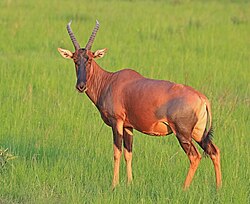| Damaliscus | |
|---|---|
 | |
| A female topi (Damaliscus lunatus jimela) | |
| Scientific classification | |
| Kingdom: | Animalia |
| Phylum: | Chordata |
| Class: | Mammalia |
| Order: | Artiodactyla |
| Family: | Bovidae |
| Subfamily: | Alcelaphinae |
| Genus: | Damaliscus P.L. Sclater & Thomas, 1894 |
| Type species | |
| Antilope pygargus Pallas, 1767 | |
| Species | |
 | |
| Subspecies range map of the genus Damaliscus | |
The genus Damaliscus, commonly known as damalisks, is a genus of antelope in the family Bovidae, subfamily Alcelaphinae, found in Africa.


